A beginner's guide to feeding pears in the fall
In autumn, the pear is fed with mineral and organic fertilizers. They are introduced by root and foliar method, carefully observing the dosage. This allows the plant to stock up on nutrients for the winter season, increases immunity to diseases, and has a positive effect on the taste of fruits and yield in the coming season.
The article will tell you how to feed a pear in the fall and how to do it right.
The content of the article
What a pear needs in autumn
Autumn feeding enriches the plant with micro- and macroelements, the reserves of which were actively consumed during the growing season. How the pear will endure the cold directly depends on this.
If the tree is not prepared, lacks mineral or organic substances, it may not withstand low temperatures.
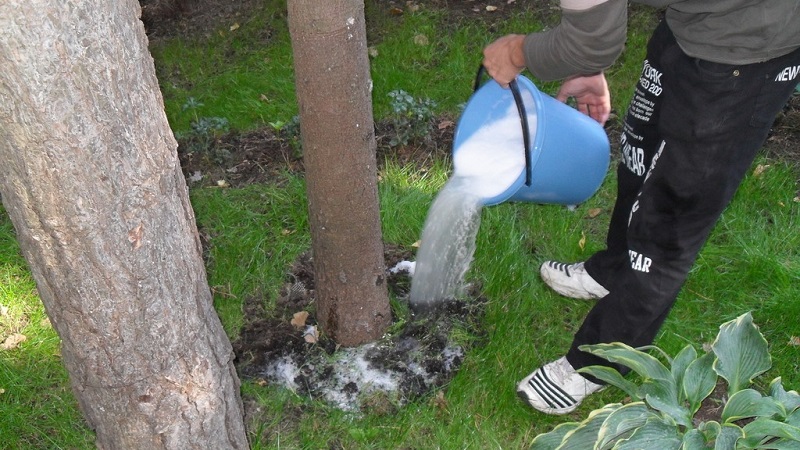
Terms of making autumn dressings
Top dressing in the autumn carried out at a time when the fruits have already been harvested, and the foliage has partially turned yellow.
The first time nutrients are applied in September. Finish no later than the beginning of November, so as not to bring down the tree development mode... Otherwise, instead of preparing for the dormant period, the pear will begin to release buds, which is destructive for it.
The plant absorbs nutrients for at least a month... If they are brought into frost, this will not give any result.
Monthly feeding calendar for pears
 IN the first time fertilization is applied in September... Use formulations containing potassium and phosphorus. This allows the tree to develop its wood properly and bud for the winter. Choose mineral fertilizers. They contain the nutrients necessary for the pear. If you feed the pear late, it will not have enough time to prepare for the cold.
IN the first time fertilization is applied in September... Use formulations containing potassium and phosphorus. This allows the tree to develop its wood properly and bud for the winter. Choose mineral fertilizers. They contain the nutrients necessary for the pear. If you feed the pear late, it will not have enough time to prepare for the cold.
As soon as the foliage falls, they carry out a sanitary pruning of the tree and proceed to the second stage. introduction of nutrients. Use drugs with potassium, phosphorus, zinc, magnesium, copper.
So that nutrients reach the root system faster and in the right amount, the pear is preliminarily watered abundantly - at least 10 liters of water at the root.
At the end of October, the tree trunk below is whitewashed with lime diluted in a solution of copper sulfate... Young trees are additionally protected from insects and rodents with a chalk emulsion.
Attention. The fertilizer should not contain nitrogen, since it will not allow the plant to switch to winter mode of life before the onset of cold weather.
Root
In autumn, fertilizers are applied in two ways: root and foliar. Each has its own characteristics.
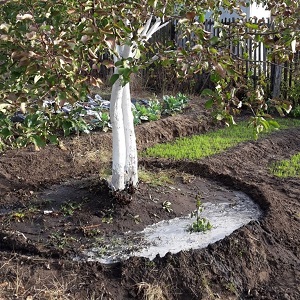 For root fertilization, grooves are dug a depth of 25 cm along the perimeter of the crown. After carefully watered the ground. Use at least 20 liters of water.
For root fertilization, grooves are dug a depth of 25 cm along the perimeter of the crown. After carefully watered the ground. Use at least 20 liters of water.
For this method, formulations with the following components are suitable:
- water - 10 l;
- superphosphate - 2 tbsp. l .;
- potassium chloride - 1 tbsp. l.
All components are thoroughly mixed and distributed over the root circle... For young plants, wood ash is additionally used to protect the fragile root system from decay. On 1m² take 100 g of ash and dig it up.
Fertilizers are added during digging... For this, dry compositions are suitable, which are evenly distributed along the near-trunk circle, then dug up.
Such substances are suitable:
- urea - 1 tbsp. l .;
- superphosphate - 2 tbsp. l .;
- phosphate rock - 1.5 tbsp. l .;
- ammofosk - 3 tbsp. l .;
- wood ash - 500 g.
Wood ash is taken for digging in the amount of 150 g per 1 m2... It is scattered at a distance of 60 cm from the trunk and mixed with earth.
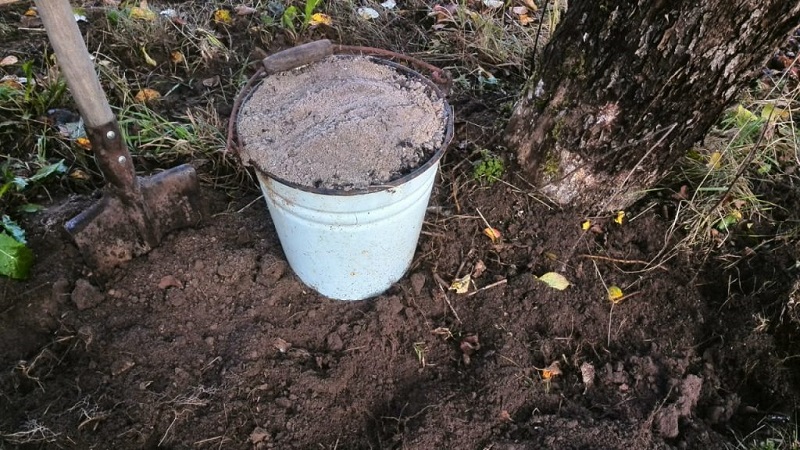
Foliar
Foliar dressing in the autumn is applied once.
The following substances are used:
- superphosphate - 2 tbsp. l .;
- potassium chloride - 1 tbsp. l .;
- water - 10 liters.
All ingredients are mixed in a bucket... The resulting solution is sprayed onto the crown at the rate of 10 liters of fertilizer per 1 m².
Interesting on the site:
Fertilizers
Fertilizers under a pear in the fall are applied to prepare the plant for the winter period, as well as compensate for the deficiency of nutrients.
The amount and composition of fertilizers is determined by the type of soil.
Organic
These are mixtures that include:
- Slurry. It is made on the basis of mullein or horse droppings. Fresh grass is added to them and insisted. This fertilizer contains a high concentration of nitrogen, so it is added in small doses so as not to damage the root system. In autumn, they are used to improve the structure of soil with a high humus content, to make it softer and looser.
- Humus. They are harvested from healthy fallen leaves, tops, weeds and green manure, which are moistened with water and left to rot for a period of 6 to 12 months. This nutritious and safe composition is brought under digging.
- Wood ash. Contains useful elements and protects against pests.
- Bone meal. It is rich in calcium and nitrogen, used for digging, no more than once every 4 years. Reduces soil acidity.
Organic fertilizing is applied to the tree trunk circle, which is dug around the perimeter of the crown. Then the soil is mulched with straw, humus and peat, taken in equal parts.
Mineral
In the fall, the pear needs most of all in mineral fertilizers containing potassium and phosphorus.... They help the tree prepare for the dormant period.
Top dressing applied carefully, carefully observing the dosage:
- water - 10 l;
- copper - 5 g;
- zinc - 10 g;
- magnesium - 200 g;
- boric acid - 20 g.
The mixture is diluted in a bucket. The resulting composition is watered at the rate of 10 liters per 1 m².
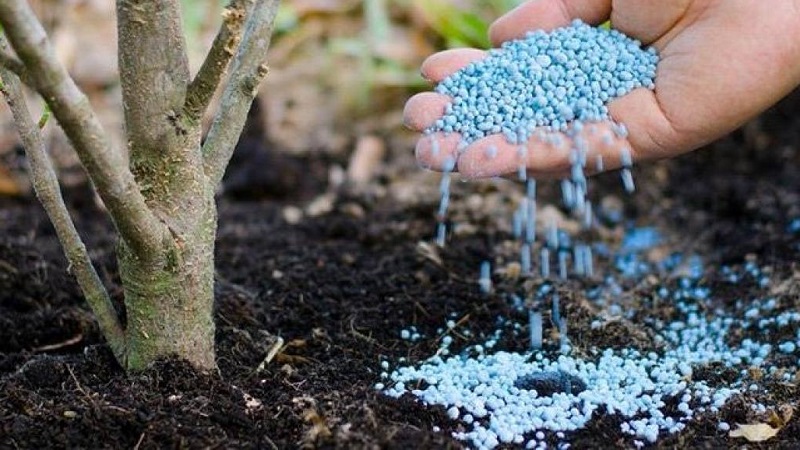
Mineral fertilizers are also used for thorough spraying of leaves, branches and shoots of a tree.... For this, a mixture is prepared based on the components:
- water - 10 l;
- superphosphate - 2 tbsp. l .;
- potassium chloride - 1 tbsp. l.
Pear treated with the resulting solution immediately after fruiting.
The best fertilizers for pears in autumn
For feeding pears in the fall, ready-made fertilizer compositions are suitable, which can be purchased in the store, or prepared according to folk recipes.
Ready funds
From ready-made formulations use "Kalimagnesia"... This is a ready-made mineral dressing, which contains potassium and magnesium. 20 g of the drug is diluted in 10 l of water. The solution is poured into the trunk circle.
They also use such complex fertilizers as:
- nitroammophoska;
- nitrophoska;
- ammophos;
- diammophos.
The composition of such dressings includes all the necessary trace elements:
- nitrogen;
- phosphorus;
- magnesium;
- potassium;
- sulfur.
The solution is made strictly according to the instructions. Observe the dosage carefully.
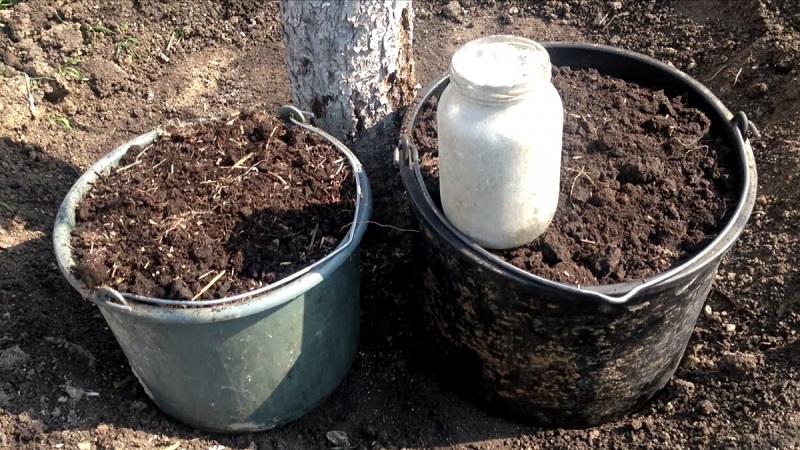
Folk recipes
Complex mineral dressing is prepared independently.
The following ingredients are required:
- ammofosk - 3 tbsp. l .;
- wood ash - 2 tbsp. l .;
- urea - 1 tbsp. l .;
- superphosphate - 2 tbsp. l .;
- phosphate rock - 1.5 tbsp. l .;
- potassium chloride - 1 tbsp. l.
All components are mixed and scattered 60 cm from the trunk... Then the earth is carefully spilled.
Organic fertilizers are also used. For example, manure and humus that have rotted for at least two years.
The amount of feeding depends on the age of the pear:
- up to 7 years - 30 kg;
- over 8 years old - 50 kg.
The specified amount is laid out around the tree and dug up... The frequency of application depends on the type of soil. If it is fertile, then the manure is used only once every two years. Wood ash is added to the composition.
Bird droppings in the autumn period are applied to the soil in a dry form... Then dug up, mixing evenly with the ground.
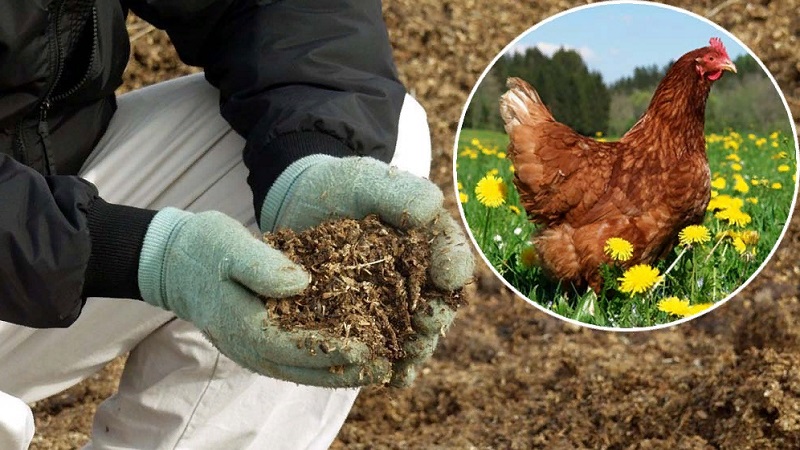
Fertilizers such as compost are also used.... It is made from rotting fruits, weeds, tops, and cut grass. Humus or manure is added to it, then the resulting mixture will be more nutritious. The compost is also laid out in the root circle and dug up.
Important. Only healthy plants are used to make compost.
After removing the fruits and digging the soil under the pear, they plant green manure... They do this so that the plants cover the roots of the tree, protecting them from frost and keeping snow.
How to properly fertilize a pear in the fall
In order for minerals to be better absorbed by the root system of the plant, follow the rules for fertilization.
Consider the following guidelines:
- Dates - late September - early November.
- Fertilizers are distributed evenly over the entire area of the trunk circle, retreating from the trunk at least 50 cm. Its size is limited by the crown of the tree.
- The dosage is strictly observed.
- They feed trees that are two years old.
- Additional trace elements are added to the soil after the entire crop has been harvested.
- When foliar top dressing, they carefully monitor that all foliage and branches are carefully and evenly processed.
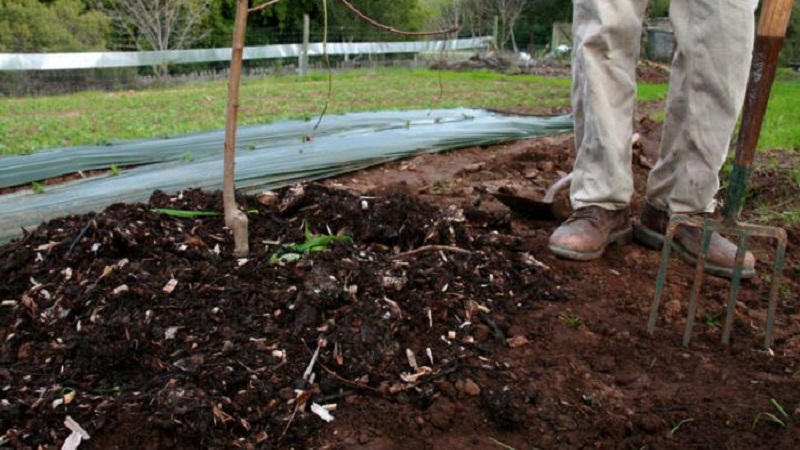
Features of autumn feeding by region
Terms and features of fertilization directly depend on the region.
In outskirts of Moscow the climate is changeable. To prepare the tree for the dormant period, humus and mulch are used. This will give the plant the necessary supply of nutrients.
In the Urals special attention is paid to foliar dressing - spraying with a composition of potassium chloride and superphosphate increases the plant's winter hardiness and immunity to diseases such as scab.
In the regions of Siberia the soil is fertile, a lot of sun, but winters are harsh. To protect the tree, they use natural mulch, ash. And green manures are planted under the plant. For example, the bent grass.
Read also:
A guide to properly preparing grapes for winter
Fertilizers for pears after harvest
After harvesting the fruits, pears are also fedto replenish the lack of nutrients in the soil that were consumed during the growing season. This is necessary so that the tree overwinters safely and produces healthy, tasty fruits in the coming season.
Use a composition of sulfuric potassium (25 g) or potassium monophosphate (15 g) per 10 liters of water. The solution is used to treat the trunk circle at the rate of 10 liters of fertilizer per 1 m².
Such an agricultural practice will help the plant to absorb nutrients before the winter period.
Conclusion
Top dressing of pears in autumn enriches the soil with compounds that the plant especially needs in winter. Fertilizers are prepared taking into account the characteristics of the soil, climate and age of trees, strictly observing the dosage.
Correctly introduced microelements help the plant to overwinter, increase its resistance to diseases and pests, and improve the taste of the future harvest.